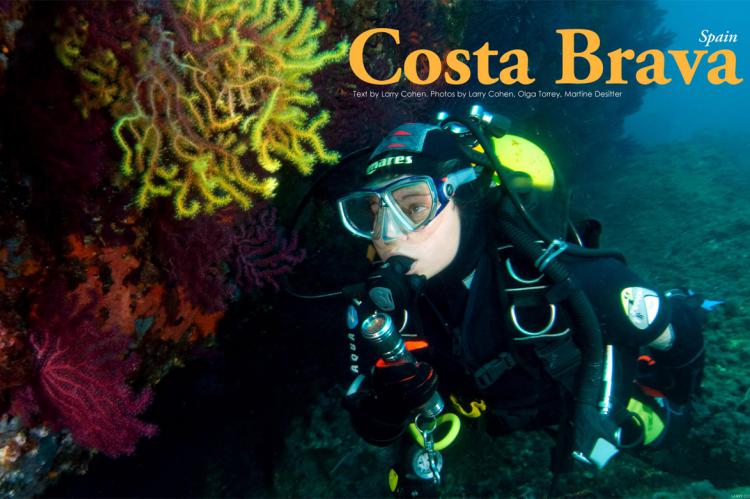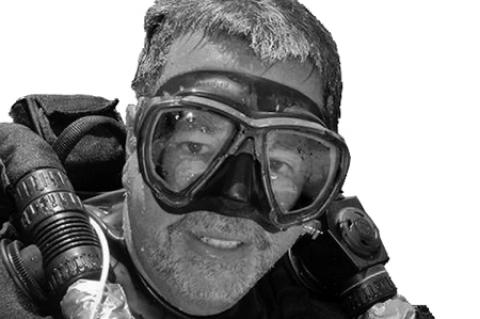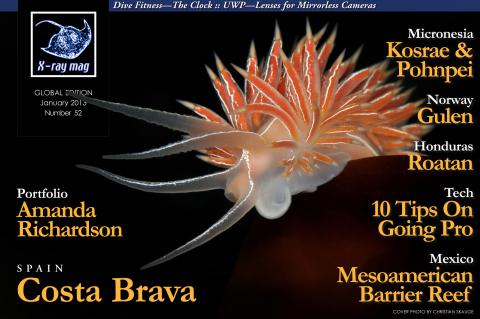Cala Joncols, Costa Brava
When people from the United States go on a European vacation, diving is usually not on the agenda. But the Costa Brava area on the northeastern coast of Spain offers some interesting diving. It might not be as colorful as the Red Sea or Indonesia, but add on the cultural experience, and it is worth a visit.
Tags & Taxonomy
Barcelona
Barcelona is about a two-hour drive from Costa Brava. On a trip from the United States this a great place to start. Barcelona offers world-class museums, cuisine and beaches. It is also a party town with plenty of clubs, and bars. Just strolling along the streets from neighborhood to neighborhood is an adventure. People watching, viewing the architecture and visiting the cafés is very compelling. Arriving from New York City on the red-eye, the time difference does take its toll. Arriving in Barcelona mid-morning, the local custom of a siesta seemed appropriate before hitting the streets.
An evening walk in the Gothic Quarter was the perfect start for our exploration of the city. The narrow streets have an abundance of restaurants and bars located in ancient Roman style buildings. Las Ramblas is one of the wider streets in the area. It is primarily a pedestrian walk with only two narrow one-way traffic roads on both sides of the central area. This gives the boulevard a street fair ambiance 24 hours a day.
Having only one full day in Barcelona, we decided to concentrate on the architecture of Antoni Gaudí. Gaudí was born in 1852 and died in 1926. He was part of the Catalan Modernista (Modernism) movement. This widescale movement reached its peak in the late 19th and early 20th centuries across all of the arts. Gaudí’s work transcended mainstream Modernism, having an organic style inspired by nature.
Gaudí rarely drew detailed plans of his works; he would create three-dimensional scale models while he was conceiving the ideas. A Gaudí building is so unique, even people who know nothing about architecture or Gaudí will intuitively be able to identify one. For this reason, UNESCO recognized his buildings as World Heritage sites in 1984.
La Pedrera is one of Gaudí’s main residential buildings and is extremely imaginative. It is located at Passeig de Gràcia 92. This structure is more a sculpture than a building. It was built during the years 1905–1910, being considered officially completed in 1912. The roof is unusual; its architectural and sculptural elements can be seen from the street. Ventilation shafts and chimneys are decorated with broken fragments of tile. The stone railings around the perimeter follow the shape of the façade. You could tell Gaudí was fond of a harmonious solution between the curves of the façade and roof.
Casa Batlló is the total restoration in 1904 of an old conventional house built in 1877. The building is located at Passeig de Gràcia 43. Gaudí replaced the original facade with a new composition of stone and glass. He redesigned the external walls to give them a wavy shape, which was then plastered with lime mortar and covered with fragments of colored glass and ceramic discs. The balcony railings are in the shape of a mask. The building was highly criticized during construction for its radical design. But in 1906, the Barcelona City Council deemed it one of the three best buildings of the year.
La Sagrada Familia is located at Carrer de Mallorca 401 in the centre of Barcelona. It has become one of the most universal symbols of the city. Construction on the church began in 1882 by the diocesan architect Francisco de Paula del Villar. At the end of 1883, Gaudí was commissioned to carry on the work. He did not abandon this project until his death. The church presents a great depiction of the relationship between man, nature and religion through its architecture and façade sculptures. Construction on the church is still taking place today. It is anticipated the church will be completed in 2026. This will be the centennial of Gaudí’s death.
When walking around Barcelona, you see signs everywhere of the Catalan independence movement. What is now the northern region of Spain was part of Catalonia since the Middle Ages. The people of this area have their own culture and language. With unemployment in Spain at an all time high, many people believe the area would be better off as an independent state. A flag with red and yellow stripes and a white star inside a triangle symbolizes the movement. This flag can be seen hanging on many balconies along the streets of Barcelona.
The drive
Getting around Europe by train is supposed to be very easy. But to get to Hotel Cala Joncols in Rosas would have required a train to Figueres, a bus to Rosas, and then a pick up with the hotel’s car. We decided that renting a car would be a more practical way to go, considering the cases and cases of equipment.
Prior to departure, we arranged to rent a Peugeot Partner, which is a small van. We went with Sixt, a popular rental company in Europe that now has a few locations in the United States. We picked the Hilton Hotel at Diagonal Mar, since it looked like it had easy access outside the city. The car rental agent spoke fluent English and gave us directions on how to exit Barcelona and get to Rosas. Once I remembered how to drive a manual transmission car, the drive went rather smoothly.
Figueres
Upon leaving the main highway, we decided to take a detour to the town of Figueres. This town has a compact historic area that has the ambiance of the Gothic Quarter of Barcelona but on a much smaller scale. The town was established during the 10th century, according to the records from the Sant Pere Monastery. The Sant Pere church is still at this location. The name Figueres means fig trees, which are abundant in the area. It is the last major town before crossing the boarder into France.
The main attraction here is the Dalí Theatre-Museum, of course featuring the work of Salvador Dalí. This is the largest surrealistic object collection in the world. The museum is located on the site of the former Municipal Theatre—a 19th century building that was destroyed at the end of the Spanish Civil War. Dalí purchased the old theatre and created his own museum in the town where he was born. Showing up at the museum on a Monday, it was closed, but the building itself and the surrounding sculptures were certainty worth the visit.
Getting there is half the fun
After leaving Figueres, we did get lost going to Rosas. The road between Figueres and Rosas had a number of round-abouts. There were signs, and then they would just disappear, so we did not know in which direction to head. After getting directions from someone who hardly spoke English, we managed to arrive at the marina in Rosas. Here, we found someone who spoke fluent English, and we asked for directions to Hotel Cala Joncols.
They directed us to a road up a steep hill. This two-way road was narrower than most one-way roads on the U.S. east coast. The road also overlooked a steep cliff. To add to the adventure, after a short drive, it turned into a rough dirt road. Considering the fact that I had not driven a manual transmission car in many years, this drive was an experience all on its own.
Once we were able to subdue the fright factor, it was a picturesque ride. Most of it was through the Cap De Creus National Park. This is the most easterly point of Spain where you see the last glimpse of the Pyrenees before they plunge into the Mediterranean Sea. Part of the park is underwater, but it is also known for bird migration. Kites, eagles and honey buzzard are just a few of the bird species that migrate past the park. Bonelli’s eagles and sea birds including Cory’s, balearic and yelkouan shearwaters call the park home.
Finally arriving at the hotel, we were so happy to get out of the car. When we commented on the experience, a hotel staff member asked jokingly, “So, you don’t like Spanish super highways?”
Hotel Cala Joncols
Besides diving, the theme of this hotel is adventure. Kayaking, hiking and mountain biking are some of the other activities. When there is a full moon, you can do a night kayak tour, which includes a guide and a bottle of cava (sparking wine). This out-of-the-way establishment has 33 rooms, and many of the guests come back every year. The hotel is only open from April to October.
The place has a fascinating history. Jose Gomez and his wife, Maria Fernandez, came to Rosas in 1969. Jose worked as a gardener for the hotel’s Italian owners. In 1970, Jose and Maria rented the hotel from the owners and ended up purchasing it in 1995. Their two sons, Michael and Manuel Gomez Fernandez, now run the hotel.
They also run a water taxi to Port LLigat. This is the village where Salvador Dalí lived. Port LLigat has been represented in several of Dalí’s paintings, such as The Madonna of Port Lligat, Crucifixion (Corpus Hypercubus), and The Sacrament of the Last Supper.
With all the outdoor activity, food is very important, and Cala Joncols does not disappoint. All the Spanish and Catalan food is very local. The family owns its own 21-foot fishing boat, which provides the seafood for the hotel. The olive trees on premises produce 3,000 kilos of olives a year, which are used to produce olive oil for the hotel.
Diving
Euro-Divers has been running the five star PADI facility at Cala Joncols since 2003, but the dive operation has existed for 20 years. Euro-Divers also has operations ...
(...)
Download the full article ⬇︎

Originally published
X-Ray Mag #52
Diving Spain's Costa Brava; Honduras' Roatan; Micronesia's Kosrae & Pohnpei; Diving Gulen, Norwegian fjord; Kids Scuba Malaysia Mabul-Sipadan Camp; Jim Hellemn profile; Why scientific diving safer; Diving the Mesoamerican Barrier Reef; Dive fitness: The Clock; Tech: 10 tips on going pro; When sharks really attack; All about mirrorless cameras lenses; Amanda Richardson portfolio; Plus news and discoveries, equipment and training news, books and media, underwater photo and video equipment, turtle news, shark tales, whale tales and much more...


